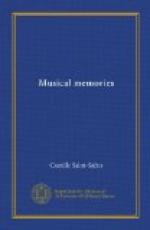Stamaty was Kalkbrenner’s best pupil and the propagator of the method he had invented. This method was based on the guide main, so I was put to work on it. The preface to Kalkbrenner’s method, in which he relates the beginnings of his invention, is exceedingly interesting. This invention consisted of a rod placed in front of the keyboard. The forearm rested on this rod in such a way that all muscular action save that of the hand was suppressed. This system is excellent for teaching the young pianist how to play pieces written for the harpsichord or the first pianofortes where the keys responded to slight pressure; but it is inadequate for modern works and instruments. It is the way one ought to begin, for it develops firmness of the fingers and suppleness of the wrist, and, by easy stages, adds the weight of the forearm and of the whole arm. But in our day it has become the practice to begin at the end. We learn the elements of the fugue from Sebastian Bach’s Wohltemperirte Klavier, the piano from the works of Schumann and Liszt, and harmony and instrumentation from Richard Wagner. All too often we waste our efforts, just as singers who learn roles and rush on the stage before they know how to sing ruin their voices in a short time.
Firmness of the fingers is not the only thing that one learns from Kalkbrenner’s method, for there is also a refinement of the quality of the sound made by the fingers alone, a valuable resource which is unusual in our day.
Unfortunately, this school invented as well continuous legato, which is both false and monotonous; the abuse of nuances, and a mania for continual expressio used with no discrimination. All this was opposed to my natural feelings, and I was unable to conform to it. They reproached me by saying that I would never get a really fine effect—to which I was entirely indifferent.
When I was ten, my teacher decided that I was sufficiently prepared to give a concert in the Salle Pleyel, so I played there, accompanied by an Italian orchestra, with Tilmant as the conductor. I gave Beethoven’s Concerto in C minor and one of Mozart’s concertos in B flat. There was some question of my playing at the Societe des Concerts du Conservatoire, and there was even a rehearsal. But Seghers, who afterwards founded the Societe St. Cecile, was a power in the affairs of the orchestra. He detested Stamaty and told him that the Societe was not organized to play children’s accompaniments. My mother felt hurt and wanted to hear nothing more of it.
After my first concert, which was a brilliant success, my teacher wanted me to give others, but my mother did not wish me to have a career as an infant prodigy. She had higher ambitions and was unwilling for me to continue in concert work for fear of injuring my health. The result was that a coolness sprang up between my teacher and me which ended our relations.
At that time my mother made a remark which was worthy of Cornelia. One day some one remonstrated with her for letting me play Beethoven’s sonatas. “What music will he play when he is twenty?” she was asked. “He will play his own,” was her reply.




